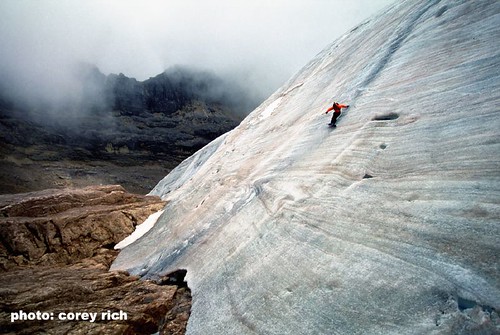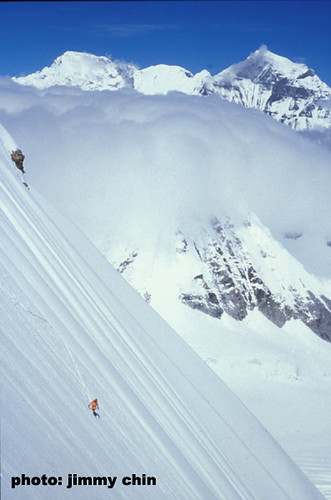A little lapse in judgment with yesterday’s post…so I removed it. Back to hard core, tough guy, manly ski mountaineering stuff.
I was CC’d on an email going around about some of the technicalities and questions people have on what qualifies a successful ski/snowboard descent, be it here in the lower forty-eight, or on an 8000M peak in the Himalayas. Though we all know that just being out in the mountains is the real goal, sometimes it is important to quantify things in order to get the point across…or so others can follow. We start the conversation off with alpinist, snowboard mountaineer and mountain guide, Stephen Koch answering a few questions.
 Stephen Koch rides some firm ‘snow’ on Puncak Jaya, New Guinea, Indonesia.
Stephen Koch rides some firm ‘snow’ on Puncak Jaya, New Guinea, Indonesia.
Courtesy Corey Rich
To claim a successful descent, should it start from the summit of a mountain?
Start at the summit if possible. I have done descents where there was no snow at the actual summit. I summited and began the descent where the snow began, and stopped turning where the ended. When you climb and descend closer to “winter”, there tends to be more snow (outside of the Himalaya). Sometimes though, a mountain will get special snow coverage at one time or another during the year and if you are “on” it, you can make a descent that may rarely, if ever be possible to do again (especially with global warming).
Are you allowed to rappel?
We / You are allowed to do whatever we deem necessary to stay alive, whatever you want…that is the beauty of the mountains. It is important that all facts are clearly stated when describing the descent though. I liken this to using aid on a climb. It is fine to do (as a last resort), but just needs to be declared.
What’s better…rappelling or downclimbing?
The ideal “descent” is to climb a virgin mountain by the route of planned descent, making a first ascent of the peak and route, then at the summit, which has snow, along with the entire route that you just climbed, great powder snow for that matter, since I am writing about the ideal. Then on the summit you take off your crampons and put on your board/s and rip the descent down to the flats at the bottom of the mountain. Well, there aren’t too many scenarios like this left, so we make due…but the bottom line is that I do what I feel comfortable with given the conditions of the route at that moment and based on my ability and how I feel at that moment. If I need to downclimb or rappel because I am not confident with either the conditions or my abilities, fine. More power to me to do this than to take a less cautious approach and possibly fall to my death. On the scale of best style, a complete descent…turning all the way is the holy grail, sideslipping past “unskiable” snow or terrain comes next, then downclimbing and finally, rappelling. Downclimbing is usually more difficult than rappelling.

Stephen Koch rides good snow on Mount Everest.
Courtesy Jimmy Chin
What if someone skis a line in better style…or conditions?
If I do a descent where I downclimb (or rappel) a section on a first descent, it is the first descent. If someone comes along the next day and does the same descent with bigger huevos or in better conditions and does not downclimb or rappel, they can say they did the first “free” descent. If they sideslip is it a “free” descent? That is an interesting one…I would say yes. Can someone sideslip an entire route and claim a descent…sure. It happens all the time in Corbett’s Couloir. Again, the bottom line is to have fun, stay alive and declare your aids.
What about huge expeditions, where a Sherpa may be carrying your gear…while you’re sucking the O’s?
The use of supported expeditions with oxygen changes everything and I think it needs to be clarified whenever referencing climbs or descents if oxygen was used. I think it is important to clarify if something done on the higher mountains (8,000 m) was done “with” or “without” oxygen. It doesn’t matter that the general public doesn’t realize or understand the difference. We as climbers do know the difference and that difference is so profound that I believe it needs, as stated earlier, to be declared with all climbs and descents of high mountains. When I was on Everest we had 2 Sherpa team members. This was definitely helpful. Is it different than paying for a strong “Western” climber to be a part of your expedition? This is a different issue for another time. Point is, declare your aids and the community can judge your claim accurately (with as many different opinions as there are people…!!!).
What if someone skis 100′, raps 2000′, then skis 100′ back to camp…valid descent?
The community will determine if the descent is valid. But the person who made the descent had an experience that is solely their own. Nobody else can know that experience. But as long as people know the facts they can judge, and judge they will! I don’t want to set any rule here. I love the mountains because of the lack of rules of men, only the ultimate rules apply…the rules of nature.
I guess I would have to say yes, it is a valid descent. Who is to say that 2000′ or 200′ or 20′ is too much rappelling for a valid descent? Another way to look at it is…is it either a complete descent…the ideal…or one where aid was used. Let’s have this reflected in the grade of the route when describing a route. For example:
XYZ Couloir- E, 2000′, AS/AD/AR, 55°
E=Extreme
AS=Aid Sideslipping
AD=Aid Downclimbing
AR=Aid RappelingOne example: when Mark Newcomb and I descended the Black Ice Couloir on the Grand Teton, we belayed the first 200′ of 60 degree snow over ice. It was my idea to use the rope. Mark wasn’t too psyched to use it, but acquiesced because I wanted to. I was scared and glad he was tied in, because on the first turn he uncovered black ice! This is not to say he would have fallen without the belay, I was just glad he was roped up and that I would be getting a belay too. Then we rappelled 200′ over unskiable / unridable 70′ water ice. Then I (not Mark) clipped into our ropes that were anchored to a V-thread (or screw) that we set. The ropes were tied together so I was on a “long” belay. Then we packed up the ropes and turned the rest of the couloir until it ended in a large cliff, that we rappelled.
There was controversy about this descent that we did in 1995. There has not been a second descent. If someone goes and does it without any belays or rappels (either jumping the big cliffs or downclimbing them) this will be better style but not the first descent. We already did that. It may be the first complete or full descent (very unlikely that someone could jump and stick the landing and not tumble to their death, but nothing is impossible). We chose to belay and rappel because of the conditions of the mountain and our ability, skill and comfort (or lack of it). I welcome someone to do a descent in better style.
That is what happens…people come along with talent, vision and the knowledge of what has been done, with what is possible and take it one step further! That is evolution and progression and what happens in climbing, snowboarding, skiing, paragliding, driving, holding our breath, going into space, looking at nano-this and that…you get the picture…it is all the same and it is called evolution!
Stephen Koch
Stephen Koch is also the father of a young boy named Axl and a realtor for Art Hazen Realty. Thanks for the input Stephen. Mark Newcomb adds his thoughts on some Teton descents in Part 2.

Thanks Steve and Stephen. Very good read.
Nicely put, Stephen. The main point of all of this stuff is to have fun and be safe.
Who knows? Maybe somebody, sometime, will actually ski the Grand.
wow, the first photo is just amazing….
good to chew such info when outside is 35 deg celsius…at least my brain will chill a little…:)
I concur Alex…tis a sweet shot! 😯
Thanks to Stephen, Corey and Jimmy for the contributions.
Interesting photos of Koch. I have the corresponding video footage in my posession………it is pretty cool too.
Good reading, as always guys.
Thanks Derek!
Footage on Everest or in Indonesia? 😯
Steve,
All of the above.